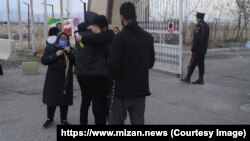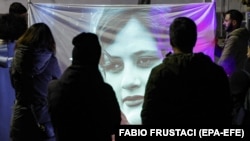
Welcome back to The Farda Briefing, an RFE/RL newsletter that tracks the key issues in Iran and explains why they matter. To subscribe, click here.
I'm RFE/RL correspondent Golnaz Esfandiari. Here's what I've been following during the past week and what I'm watching for in the days ahead.
The Big Issue
Scores of Iranian protesters and prominent political prisoners have reportedly been released in recent weeks under a limited amnesty announced by the authorities. They are said to include Iranian-French academic Farina Adelkhah, award-winning filmmaker Mohammad Rasulof, and human rights activist Farhad Meysami.
The authorities have not provided an official list of those released. But Iran’s reformist Etemad daily ran photos of some 50 newly freed figures on its front page on February 13. The newspaper reported that nearly 400 prisoners had been released as of February 11, adding that judicial officials were reviewing more cases.
The reported releases come after Supreme Leader Ayatollah Ali Khamenei on February 5 ordered an amnesty and the reduction of sentences for some prisoners. The announcement came ahead of the 44th anniversary of the Islamic Revolution on February 11.
Why It Matters: The authorities have arrested some 20,000 people during the ongoing anti-regime protests that erupted in September. Many of them remain in detention, despite the amnesty.
Rights groups and activists have downplayed the limited amnesty. Hadi Ghaemi, executive director of the New York-based Center for Human Rights in Iran, said the “so-called ‘pardon’ is nothing but a shameless public relations stunt that shows the completely arbitrary nature of justice in the Islamic republic, where arrests and releases are at the whim of the state.”
The Etemad daily, however, noted that such an amnesty is rare and could be “a sign of change” in the country. Others have called it a retreat by the clerical regime in the face of the protests, the biggest challenge to the authorities in decades.
"This is an achievement by the protest movement. The establishment would not release prisoners easily. They are in a position of weakness,” Paris-based political activist Taghi Rahmani, who has been jailed a number of times by the Islamic republic, told RFE/RL’s Radio Farda.
What's Next: More protesters and political prisoners could be released in the coming days. The authorities have been urged to free jailed journalists, activists, and environmentalists.
Despite freeing some of the regime's critics, the authorities are still going after other opponents. Reza Khandan, the husband of jailed human rights advocate Nasrin Sotoudeh, told RFE/RL's Radio Farda on February 14 that he has been summoned by the judiciary and ordered to serve a six- year suspended prison sentence.
Stories You Might Have Missed
- The presence of a Shah-era intelligence chief accused of human rights abuses at a pro-democracy rally in the United States has led to controversy among Iranians. Parviz Sabeti, the former deputy head of SAVAK, the feared security and intelligence service of the former shah of Iran, Mohammad Reza Pahlavi, was photographed at a rally on February 12.
- Several female protesters who were detained in Tehran during Iran’s brutal crackdown on antiestablishment protests spoke to Radio Farda. The women recalled the mistreatment they suffered at the hands of government agents and security officers, and described how they were beaten, threatened, and psychologically abused.
What We're Watching
A group of exiled opposition figures met at Georgetown University in Washington on February 10 to discuss the future of Iran’s pro-democracy movement. The group pleaded for unity and an end to infighting to help replace Iran's theocratic system with a secular democracy.
The attendees included the exiled former crown prince of Iran, Reza Pahlavi, and rights activist Masih Alinejad.
"The Islamic republic has survived because of our differences, and we should put our differences aside until we come to the polling booth," Nobel laureate Shirin Ebadi, a member of the exiled group, said in a video message to the gathering.
What's Next: The group said it was working on establishing a charter for a transition to a new democratic system that would be followed by free elections. It remains unclear whether the group of eight exiled opposition figures and their proposals for a new political system will receive the backing of Iranian protesters and opposition figures inside Iran.
That's all from me for now. Don't forget to send me any questions, comments, or tips that you have.
Until next time,
Golnaz Esfandiari
If you enjoyed this briefing and don't want to miss the next edition, subscribe here. It will be sent to your inbox every Wednesday.





